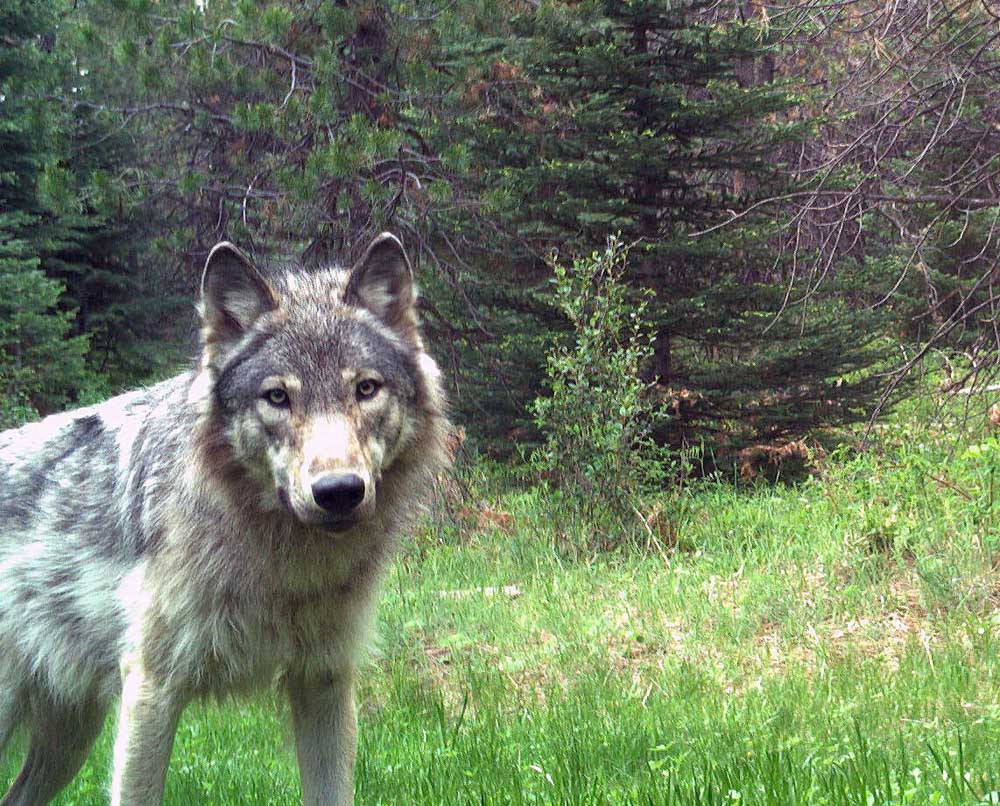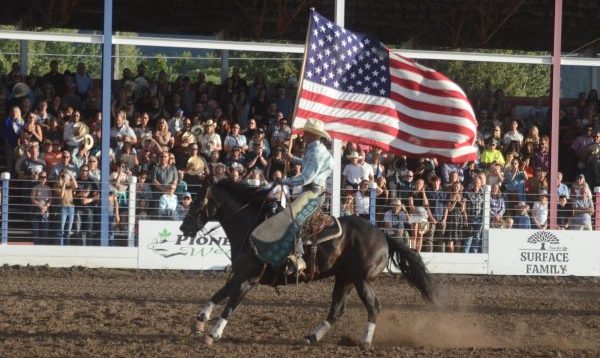ODFW changes report on attack on sheep
Published 5:00 pm Monday, May 16, 2022

- Northeast Oregon ranchers are seeing a spate of wolf predations on livestock this year and no end is yet in sight.
WALLOWA COUNTY — More wolf attacks on livestock have been reported by producers and confirmed by the Oregon Department of Fish and Wildlife over the past week, according to the ODFW’s livestock depredation report.
In the most recent report posted on the ODFW’s website Thursday, May 12, another four calves and a cow were found dead In Wallowa County alone and one calf wounded and taken for treatment this month. Most of the attacks were confirmed as done by wolves, although one calf attack was listed as “possible/unknown” by ODFW. Other attacks were reported in neighboring counties.
Trending
Sheep attack reviewed
A review of predator attacks on five sheep April 29 in Wallowa County has led to a change in the ODFW’s determination of “other” to “confirmed” wolf kills on three of the sheep, according to an ODFW official.
Michelle Dennehy, agency spokeswoman, said in an email Thursday, May 12, that because of a review requested by the sheep owner May 4, that one ewe and three lambs had “injuries and hemorrhage consistent with both coyote and wolf attack locations.” Given an analysis of the wounds and the fact that a “thick wool covering which can be a barrier to effective biting by coyotes,” the attack on the two ewes and one lamb were amended to “confirmed” for wolf kills.
The May 11 report also stated that two of the lambs killed the night before the investigation were still determined as “other.”
The report determined the attacks “could have been done by a dispersing wolf or wolves, or the Chesnimnus or Wildcat packs.”
The owner of the sheep was not identified by the agency or by local officials who attended the investigation.
Trending
County Commissioner Todd Nash, a local rancher and president of the Oregon Cattlemen’s Association, said at the time the sheep producer did not wish his name to be made public.
Nash and John Williams, co-chairman of the OCA’s wolf committee, had been critical of the ODFW’s investigation.
“They were just wrong,” Nash said May 4, and said he was going to speak to agency director Curt Melcher. “That’s a matter of an inaccurate investigation.”
Nash and Williams saw wolf tracks near the slain sheep and no fresh coyote tracks, they said.
Beth Quillian, a watersheds communications coordinator for ODFW, said in an email May 13 that based on the review, the sheep owner can request compensation through the Oregon Department of Agriculture’s wolf depredation compensation program for the two ewes and one lamb confirmed as wolf kills.
She said the agency also recommends producers employ nonlethal means to ward off wolves.
“This location is outside the large area of known wolf activity for Northeast Oregon, so if the producer hasn’t been doing so already, they will want to start to implement or improve upon nonlethal tools to reduce future conflict,” she said.
Investigations
Dennehy said in an email that livestock producers may request a review of an investigation and an “experienced wildlife biologist and agency expert on depredation” who was not involved in the original investigation will review reports. All investigations look for evidences such as the type and depth of wounds from teeth, tracks and how the attacks compare with those of various predators, such as wolves, coyotes, bear and cougars.
In the April 29 attack on sheep, it was noted that the attacks on the ewes were inconsistent with coyote attacks and thus, attributed to wolves.
“The review focuses on whether the evidence collected supports the original determination that was made,” Dennehy said.
Since the review investigators made a different determination, the online report was updated.
Lethal take permits
Since the ODFW issued a kill permit for two wolves April 29 that’s good until May 24, one wolf was taken by an agent of Tom Birkmaier, the Crow Creek rancher who had lost several cattle to wolves. Birkmaier declined to identify the agent over concern pro-wolf advocates may harass him.
Dennehy said one more wolf can be taken from the two pastures designated as zones permissible for wolf harvest.
“Lethal take permits are meant to give livestock producers an additional tool to deal with a conflict on their own,” she said. “An added benefit of this tool is the increased pressure and human presence it brings, which may also help prevent chronic depredation.”
However, it doesn’t always work and sometimes the removal of an entire pack is necessary to stop chronic depredation.
“Incremental take (taking a few wolves rather than an entire pack) is a tool the agency uses to balance the conservation of wolves with the need to address chronic depredation,” she said. “Sometimes it succeeds in significantly slowing or stopping chronic depredation, and sometimes it doesn’t.”
She emphasized that ODFW will remove an entire pack when incremental take is insufficient.
“It’s called the ‘caught-in-the-act rule.’ It gives (a producer) more flexibility,” she said, adding that even without a kill permit, “he still would have the caught-in-the-act (permission) anywhere he has his cattle.”
However, as Nash pointed out, ranchers are legally permitted to kill wolves caught harassing their livestock. Ever since 2015 when wolves were removed from the state’s endangered species list, ranchers on the east side of the state have been allowed to kill wolves harassing livestock.
Nash said ODFW should be conducting the lethal take, rather than leaving it up to the ranchers. All it takes is two confirmed predations for the ODFW to agree to incremental take.
“Then you have, with the Birkmaiers, enough for ODFW to take effective management practices to stop the depredation and the onus has been put back on the rancher rather than ODFW taking action,” he said.
Producers have enough to do
As Birkmaier said, he’s spending all his time protecting his cattle when he should be doing other ranch chores — and spending time with his wife and children.
Late April and early May are generally the busiest time of year for a Wallowa County rancher, he said. There’s fences to repair and maintain, preparation for irrigation season and fieldwork. But he’s had to spend most of his time guarding his cattle against wolves.
“I bet in the past eight or nine days I’ve been with the cows 20 hours a day,” Birkmaier said May 3 — and little has changed since.
Kelly Birkmaier, Tom’s wife and partner in the ranch, said May 16 that she is not aware of any wolf attacks in the previous week. She said she believes that’s largely because of the assistance they have received from neighbors and fellow ranchers.
“A lot of that has had to do with people who’ve volunteered their time and energy and are reporting when they see things,” she said. “I suspect that if we did not have all the help that we would be experiencing more of a loss.”
Kelly Birkmaier said the actual financial cost to a rancher of the wolf predations is difficult to ascertain and the state’s wolf compensation fund does not adequately remunerate ranchers for their losses.
“How do you calculate all this cost?” she said. “At this point, with all the time people have been out here, (the cost) is way above and beyond what the state compensates you for.”
There’s also the cost in both the man hours spent guarding the cattle and the physical body stress on the animals caused by wolf predation.
“If you’re talking about all the people who’ve been helping Tom out, you’re probably talking 15 hours a day,” she said.
Depredations change behavior
The attacks by wolves effectively change the behavior of both predators and prey. As the OCA’s wolf committee co-chairman Williams said, when people are alarmed enough to go after the wolves, the predators simply move on to another area.
“With wolves, they’ll travel 60-70 miles a day. The scale of these animals is so incredible,” he said. “You don’t solve the problem; you just change who’s getting eaten.”
It also causes the cattle to be nervous and lose body weight.
“Over the past 10 days to two weeks, they’ve lost body condition score,” Tom Birkmaier said.
Body condition score is a method ranchers use to determine the health of their cattle. One point in body condition equals about 90 pounds, Williams said.
“When they’re nervous, they’re not going to breed,” he said.
Kelly Birkmaier said the cattle’s grazing patterns change, too, and they damage the ground they’re supposed to be grazing upon.
“They’re all bunching up because they’re scared instead of spreading out and grazing,” she said.
Tom Birkmaier also said the presence of wolves that makes his cattle nervous affects how they behave around other, less-threatening predators such as coyotes.
“I’ve never seen my cows this way,” he said. “Generally they ignore a coyote, now they panic and run. They go into full panic. … Cattle this time of year ignore coyotes and coyotes ignore them.”









